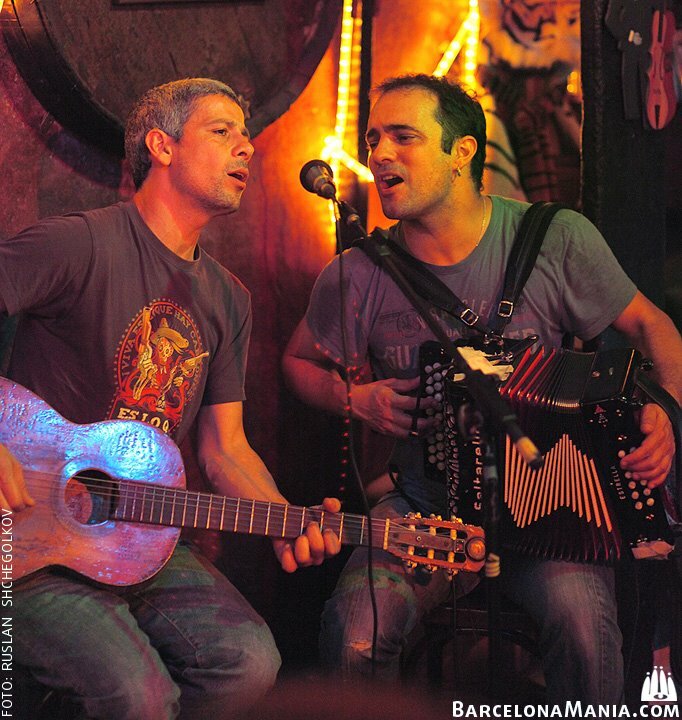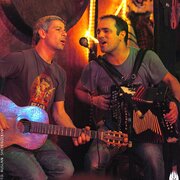- country:Belgium
- style(s):Latin, Pop
- label:not signed
- type:Duo
- gender:male
- artist posted by:Via Lactea
Line up
- Joan Garriga
Links
Short and sweet: Joan Garriga is one of the key figures of the Catalonian and
Spanish pop music of this century. As the main leader of Dusminguet and La Troba
Kung-Fú he just created a new genre, rumbia, a formidable mix between gipsy
rumba and latin cumbia that explodes to infinity and beyond on his flammant EP,
Nocturns de vetlla i revetlla (2019). This is not only the first release under his real
name but his debut of his new band, el Mariatxi galactic, a powerful combo inspired
by the sound of the Mexican norteños where you can find his old pal Marià Roch
on bass, Madjid Fahem (guitar player of Manu Chao and La Ventura) and the drums
of the incredible “Rambo”.
This is (much) more than the new adventure of Joan Garriga (La Garriga,
Vallès Oriental, 1972), who grew up in a time when, in Catalonia, the dance bands
were helping people to regain the streets, the squares and the cities, dignifying the
popular feasts and freeing the enjoyment that had been imprisoned during the dark
and silent years of the dictatorship. As he has said in many interviews, the
atmosphere of those popular dances, where different kinds of music and all
generations mingled, was crucial for his musical and vital development.
In 1995, Garriga -already playing the diatonic accordion- and two more
musicians, created the band Dusminguet, which was, from its very beginning, a
different kind of band amongst the Catalonian musical scene. In those times,
Barcelona was considered the capital city of the South, and many musicians, from
all over the world, came to play in its streets. Globalization left its mark on the band
and led it to include in its repertoire musical styles as varied as rhythms from the
Balkans, tex-mex, vallenato, cumbia, reggae, hip-hop, cajun, habaneras.
Dusminguet, a ground-breaking and unclassifiable band, was amongst the pioneer
bands in mixing musical rhythms and styles, although later on, it got under the label
of “mestizo music”. In 2004, after having played in many different countries, and at
the highest point of their success, they disbanded, feeling that they had reached
the end of their trip.
During that final stage, Garriga earned for himself a great reputation as
accordionist, one of the few to take seriously the diatonic. He played with Amparo
Sánchez (Amparanoia), and many other bands asked him for his collaboration. It
was then when he started to work with Marià Roch (former Sencillos and Jarabe de
Palo), with whom he shared territory and musical energies. From this meeting of
minds, a new project started to get underway: La Troba Kung-Fú.
La Troba Kung-Fú vindicates its three main foundations: la troba, (the
“composition”) as a means of creating songs and composing music in a way similar
to that of the old minstrels and troubadours, “finding” the inspiration and the
melodies in the life that surrounds the artist; the kung-fu, that is to say, the art of
discipline aimed to achieve perfection, and the Catalan rumba, a genre created by
the Catalan gypsies during the decade of the rock & roll, listening to mambos and
sones, and dancing at parties and weddings, and that some intellectual paios
conceptualized as an urban and popular music, genuine of Barcelona. La Troba
Kung-Fú choose the Catalan rumba as a musical language that showed itself rooted
in the origins, and reclaim it as such. And so, a new band started to play around,
formed by paio and gypsy musicians, and led by Joan Garriga, composer of the
songs, main singer and accordionist.
Their first album was Clavell Morenet (2006), which surprised the public
with, among other brilliant pieces, La cançó del lladre (The thief song), a fresh and
“rumby” version of a traditional Catalan song. This album marks and inflection point
in the history of Catalan rumba, as it showed the permeability of a genre rather local
but played with a global vision that highlights its complicity with some American
and African rhythms. The album was a starting point toward the future in which we
have already been living for some time. It clearly marked the beginning of what was
in store for the Catalan rumba, while it drew the way toward a new crossbreed
fusion, a new potent cocktail that was to come in the following years: the rumbia.
The second album, A la panxa del bou (2010), is more rock, more urban,
and a real step forward for the band. It was brewed by La Troba during their concert
trips. It was conceived as a travel diary and includes different types of music, stories
and landscapes from the places where they had been playing at: Bushwick,
Brooklyn, NY, in the States; Guanajuato o León, in Mexico; Madrid; Barcelona, and
even their hometown: La Garriga. In this album, the rumbia (a fusion of rumba and
cumbia, and much more than that) started to take shape as a personal design for a
time yet to come.
In 2013, they released Santalegria, La Troba’s third and final album. The
repertoire draws a very local landscape: industrial areas, motorways, toll zones, half
build houses, urban development left abandoned. At the same times, that
landscape becomes universal, since it shows the skeletons of the building that, here
and everywhere, the property speculation left behind. Santalegria, presents the
rumbia as a declaration of the principles the band stands for. Rumbia, transatlantic,
that comes and goes, that brings together and creates ties, that clearly shows that
the world is smaller than they want us to believe, that the people can understand
each other better by listening to each other. Music is already the language that
defines people, their way of being, of dancing, of feeling moved and thrilled.
MAIN FESTIVALS AND CONCERTS:
Joan Garriga as La Troba Kung-Fú’s leader has taken its music around Europe,
United States, Maghreb or Mexico. It’s been in the stage of the Global Fest and
Lincoln Center (NYC); Popkomm Fest (Germany); Polé Polé, Festival Afrolatino
and World Feast (Belgium); Lowlands, Zomerparkfeest and Valkhof Affaire
(Holland); Babel Med, Les Méditerranénnes and Le Bout du Monde (France);
Ariano Folk (Italy); Festichan (Arquiña), Womad (Canary Island); Cervantino
Festival (Mexico); Sziget Festival (Hungary), La Linea Festival (London),
International Arts Festival Salisbury (England); Festival Alegria (Morocco); MIR
Sibiri Shushenskoye (Siberia), and many more. Also of notice, is the French tour
during the last summer, with Manu Chao, and, formerly, the tour in England with
Ojos de Brujo.



